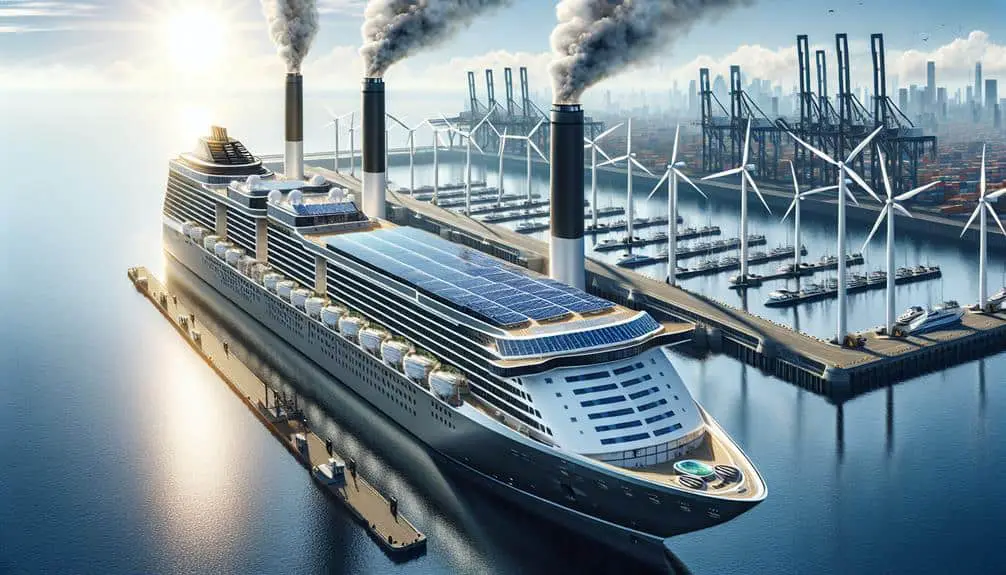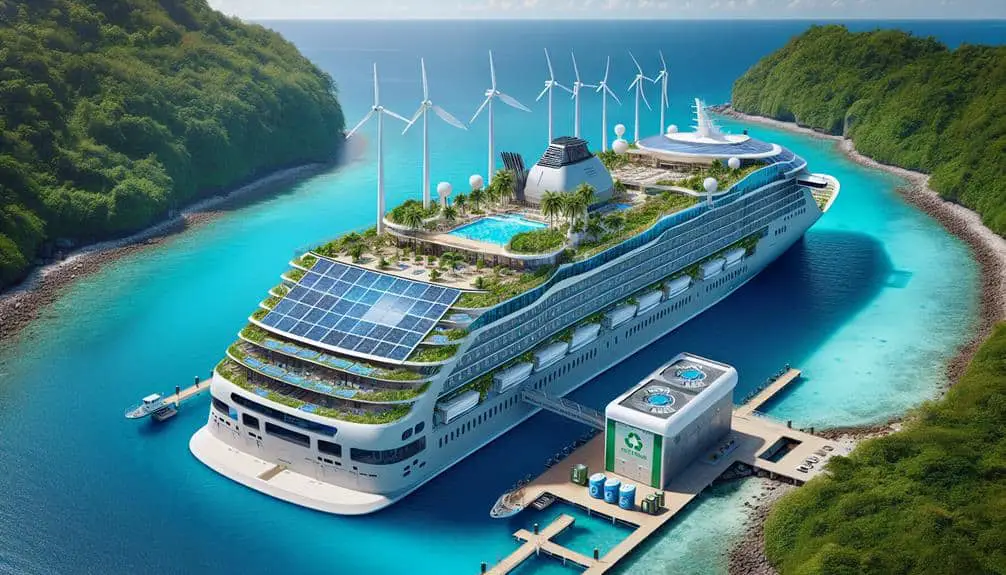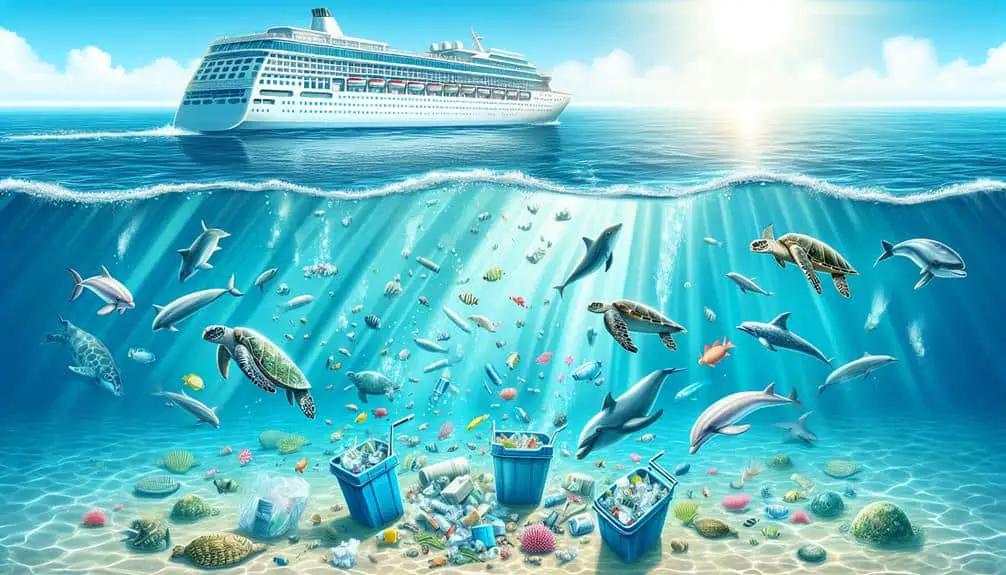Cruise ships are cutting carbon emissions to meet strict rules, trim costs, and back sustainability. They're installing cutting-edge engines, changing routes, and using solar or wind power. By switching to cleaner fuels and reducing fossil fuel use, ships abide by laws, save money, and lessen pollution. Opting for shore power curbs fuel burning in ports and cuts noise. This helps cities' air quality and green efforts. The vessels are evolving with biofuels, electric tech, and alternative energy, all to shrink their carbon footprint. Improved designs and eco-friendly waste management also play key roles in the push for greener cruising.
Key Points
- Meet environmental regulations and standards.
- Minimize ecological impact on marine ecosystems.
- Enhance sustainability practices in the industry.
- Reduce carbon footprint to combat climate change.
- Embrace cleaner and renewable energy sources.
Fuel-efficient Technologies
To minimize carbon emissions, cruise ships can implement fuel-efficient technologies such as advanced propulsion systems and optimized route planning.
Incorporating renewable energy sources like solar panels or wind turbines can greatly reduce the reliance on traditional fossil fuels, lowering emissions and overall environmental impact.
Sustainable practices, such as utilizing hybrid engines that switch between traditional fuels and cleaner alternatives, offer a practical solution for cruise lines aiming to decrease their carbon footprint.
Onshore Power Supply
Implementing onshore power supply systems at ports can further reduce carbon emissions from cruise ships by allowing them to connect to the local electrical grid while docked, minimizing the need to run onboard generators. This solution is effective in addressing noise pollution and offers notable cost savings to cruise lines. Here's why onshore power supply is an important step in the journey towards sustainable cruising:
- Reduction in Emissions: Onshore power supply eliminates the need for ships to burn fuel while in port, leading to a direct decrease in greenhouse gas emissions.
- Noise Pollution Mitigation: By switching to onshore power, cruise ships can significantly reduce noise pollution in port areas, enhancing the overall environmental impact.
- Operational Cost Savings: Connecting to the local grid can result in substantial cost savings for cruise lines by reducing fuel consumption and maintenance associated with onboard generators.
- Improved Air Quality: With fewer emissions being released into the atmosphere, onshore power supply contributes to better air quality in port cities, benefiting both residents and the environment.
- Regulatory Compliance: Utilizing onshore power supply helps cruise lines adhere to increasingly stringent environmental regulations, ensuring sustainable operations in the long term.
Alternative Fuels Adoption
The utilization of alternative fuels in cruise ship operations presents a promising solution to reduce carbon emissions and enhance environmental sustainability. Biofuel innovation stands out as a key aspect of this shift towards greener practices. By incorporating biofuels derived from organic materials like algae or plant oils, cruise ships can notably decrease their carbon footprint. These fuels offer a renewable and cleaner alternative to traditional fossil fuels, making them a viable option for sustainable maritime transportation.
Electric propulsion is another vital element in the adoption of alternative fuels by cruise ships. The integration of electric propulsion systems allows for efficient power generation and distribution, leading to lower emissions and improved energy utilization. Cruise lines are increasingly investing in hybrid electric systems and fully electric vessels to minimize environmental impact while maintaining high performance standards.
Energy-Efficient Designs
Energy-efficient designs play a pivotal role in optimizing operational performance and reducing environmental impact within the cruise ship industry. When it comes to creating energy-efficient cruise ships, incorporating eco-friendly materials and implementing green building practices are essential strategies that can greatly enhance sustainability efforts.
Here are five key elements to take into account:
- Advanced Insulation Techniques: Utilizing high-quality insulation materials helps to minimize heat transfer, reducing the energy required for heating and cooling onboard spaces.
- LED Lighting Systems: Installing energy-efficient LED lighting not only lowers electricity consumption but also contributes to longer-lasting illumination.
- Optimized Hull Design: Streamlined hull shapes and coatings reduce drag, improving fuel efficiency and overall performance.
- Renewable Energy Sources: Integrating solar panels or wind turbines can harness natural resources to generate power, reducing reliance on traditional fuels.
- Smart HVAC Systems: Implementing intelligent heating, ventilation, and air conditioning systems can regulate energy usage based on occupancy levels and environmental conditions.
Waste Management Strategies
To effectively manage waste on cruise ships, adopting innovative recycling programs can greatly reduce environmental impact and enhance sustainability efforts. Sustainable practices in waste management are essential for the cruise industry to minimize its ecological footprint. Implementing thorough recycling initiatives onboard can notably decrease the amount of waste sent to landfills and mitigate pollution risks associated with improper disposal.
Frequently Asked Questions
What Impact Do Cruise Ships Have on Marine Life and Ecosystems?
Your investigation explores the profound influence of cruise ships on marine life and ecosystems. Comparable to a sculptor shaping clay, their impact on biodiversity and coral reefs protection requires meticulous attention and innovative solutions.
How Do Cruise Ships Contribute to Air Pollution in Ports and Coastal Areas?
In ports and coastal areas, cruise ships contribute to air pollution, causing port pollution and coastal contamination. To address these issues, cruise lines are implementing measures like shore power and cleaner fuels to reduce emissions.
Are There Any Regulations or Policies in Place to Monitor and Control Emissions From Cruise Ships?
To control emissions from cruise ships, international regulations like MARPOL Annex VI establish standards for sulfur oxides and nitrous oxides. Monitoring and enforcement guarantee compliance, with measures such as emission control areas and exhaust gas cleaning systems in place to reduce environmental impact.
How Do Cruise Ships Manage and Dispose of Waste Materials Such as Sewage and Garbage?
You manage waste by segregating it onboard, utilizing recycling initiatives for materials like glass, paper, and plastics. Waste management is vital, with advanced systems onboard to treat sewage and reduce environmental impact.
What Steps Can Passengers Take to Minimize Their Carbon Footprint While on a Cruise?
To minimize your carbon footprint while on a cruise, adopt green initiatives like reusing towels, conserving water, and opting for shore excursions that support sustainable practices. Small changes collectively make a significant environmental impact.




